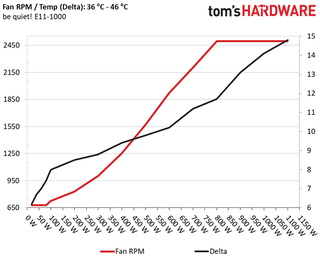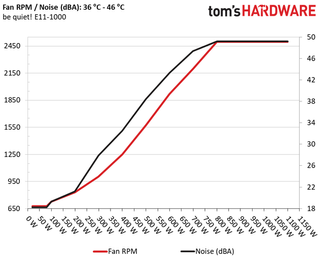be quiet! Straight Power 11 1000W
Why you can trust Tom's Hardware
Efficiency, Temperature & Noise
Efficiency
Our efficiency testing procedure is detailed here.
Using results from the previous page, we plotted a chart showing the E11-1000's efficiency at low loads, and loads from 10 to 110 percent of its maximum-rated capacity.




be quiet!'s 1000W offering doesn't stack up well against its competition under light and normal loads.
Efficiency At Low Loads
In the following tests, we measure the E11-1000's efficiency at loads significantly lower than 10 percent of its maximum capacity (the lowest load the 80 PLUS standard measures). The loads we dialed were 20, 40, 60, and 80W. This is important for representing when a PC is idle, with power-saving features turned on.
| Test # | 12V | 5V | 3.3V | 5VSB | DC/AC (Watts) | Efficiency | Fan Speed | PSU Noise | PF/AC Volts |
|---|---|---|---|---|---|---|---|---|---|
| 1 | 1.184A | 0.493A | 0.475A | 0.196A | 19.351 | 63.837% | 677 RPM | 18.2 dB(A) | 0.865 |
| 12.053V | 5.046V | 3.354V | 5.100V | 30.313 | 115.33V | ||||
| 2 | 2.451A | 0.989A | 0.983A | 0.393A | 39.824 | 76.468% | 677 RPM | 18.2 dB(A) | 0.936 |
| 12.052V | 5.043V | 3.352V | 5.093V | 52.079 | 115.30V | ||||
| 3 | 3.643A | 1.486A | 1.459A | 5.085A | 59.305 | 81.240% | 677 RPM | 18.2 dB(A) | 0.958 |
| 12.058V | 5.041V | 3.349V | 5.085V | 73.000 | 115.28V | ||||
| 4 | 4.905A | 1.982A | 1.970A | 0.788A | 79.717 | 84.490% | 677 RPM | 18.2 dB(A) | 0.969 |
| 12.056V | 5.038V | 3.347V | 5.080V | 94.351 | 115.25V |
Under light loads, the highest-capacity Straight Power 11 model doesn't do so well, dropping below 65% efficiency with 20W. Also, it cannot achieve 80% efficiency with 40W.
5VSB Efficiency
The ATX specification, along with CEC, ErP Lot 3 2014 and ErP Lot 6 2010/2013, states that 5VSB standby supply efficiency should be as high as possible, recommending 75 percent or higher with 550mA, 1A, and 1.5A of load. The PSU should also achieve higher than 75% efficiency at 5VSB under full load, or with 3A if its max current output on this rail is higher than 3A.
We take six measurements: one each at 100, 250, 550, 1000, and 1500mA, and one with the full load the 5VSB rail can handle.
| Test # | 5VSB | DC/AC (Watts) | Efficiency | PF/AC Volts |
|---|---|---|---|---|
| 1 | 0.100A | 0.511 | 79.595% | 0.051 |
| 5.112V | 0.642 | 115.25V | ||
| 2 | 0.250A | 1.276 | 82.750% | 0.116 |
| 5.106V | 1.542 | 115.25V | ||
| 3 | 0.550A | 2.803 | 83.772% | 0.221 |
| 5.097V | 3.346 | 115.25V | ||
| 4 | 1.000A | 5.081 | 83.597% | 0.320 |
| 5.082V | 6.078 | 115.25V | ||
| 5 | 1.500A | 7.610 | 81.078% | 0.386 |
| 5.074V | 9.386 | 115.24V | ||
| 6 | 2.999A | 15.081 | 79.861% | 0.464 |
| 5.029V | 18.884 | 115.23V |


The 5VSB rail is highly efficient, as we've come to expect from newer high-end FSP platforms.
Power Consumption In Idle And Standby
In the table below, you'll find the power consumption and voltage values of all rails (except -12V) when the PSU is idle (powered on, but without any load on its rails), and the power consumption when the PSU is in standby mode (without any load, at 5VSB).
| Mode | 12V | 5V | 3.3V | 5VSB | Watts | PF/AC Volts |
|---|---|---|---|---|---|---|
| Idle | 12.058V | 5.027V | 3.336V | 5.090V | 7.040 | 0.384 |
| 115.3V | ||||||
| Standby | 0.044 | 0.004 | ||||
| 115.3V |


Vampire power is low under both voltage inputs.
Fan RPM, Delta Temperature, And Output Noise
Our mixed noise testing is described in detail here.
The first chart below illustrates the cooling fan's speed (in RPM), and the delta between input and output temperature. The results were obtained at 36°C (96.8°F) to 46°C (114.8°F) ambient temperature.

The next chart shows the cooling fan's speed (again, in RPM) and output noise. We measured acoustics from one meter away, inside a hemi-anechoic chamber. Background noise inside the chamber was below 6 dB(A) during testing (it's actually much lower, but our sound meter’s microphone hits its floor), and the results were obtained with the PSU operating at 36°C (96.8°F) to 46°C (114.8°F) ambient temperature.

The following graph illustrates the fan's output noise over the PSU's operating range. The same conditions of the above graph apply to our measurements, though the ambient temperature was between 30°C (86°F) to 32°C (89.6°F).

The lack of a semi-passive mode doesn't affect the PSU's output noise much, since its cooling fan has a low start-up voltage. As a result, we measure an equally low minimum speed.
Under demanding loads, be quiet!'s fan profile is a bit more aggressive than it should be, even in normal ambient environments. Beyond 550W, the PSU exceeds 30 dB(A). Above 790W, the cooling fan spins faster still, exceeding 40 dB(A).
MORE: Best Power Supplies
MORE: How We Test Power Supplies
MORE: All Power Supply Content
Current page: Efficiency, Temperature & Noise
Prev Page Load Regulation, Hold-Up Time & Inrush Current Next Page Protection FeaturesStay on the Cutting Edge
Join the experts who read Tom's Hardware for the inside track on enthusiast PC tech news — and have for over 25 years. We'll send breaking news and in-depth reviews of CPUs, GPUs, AI, maker hardware and more straight to your inbox.
Aris Mpitziopoulos is a Contributing Editor at Tom's Hardware US, covering PSUs.